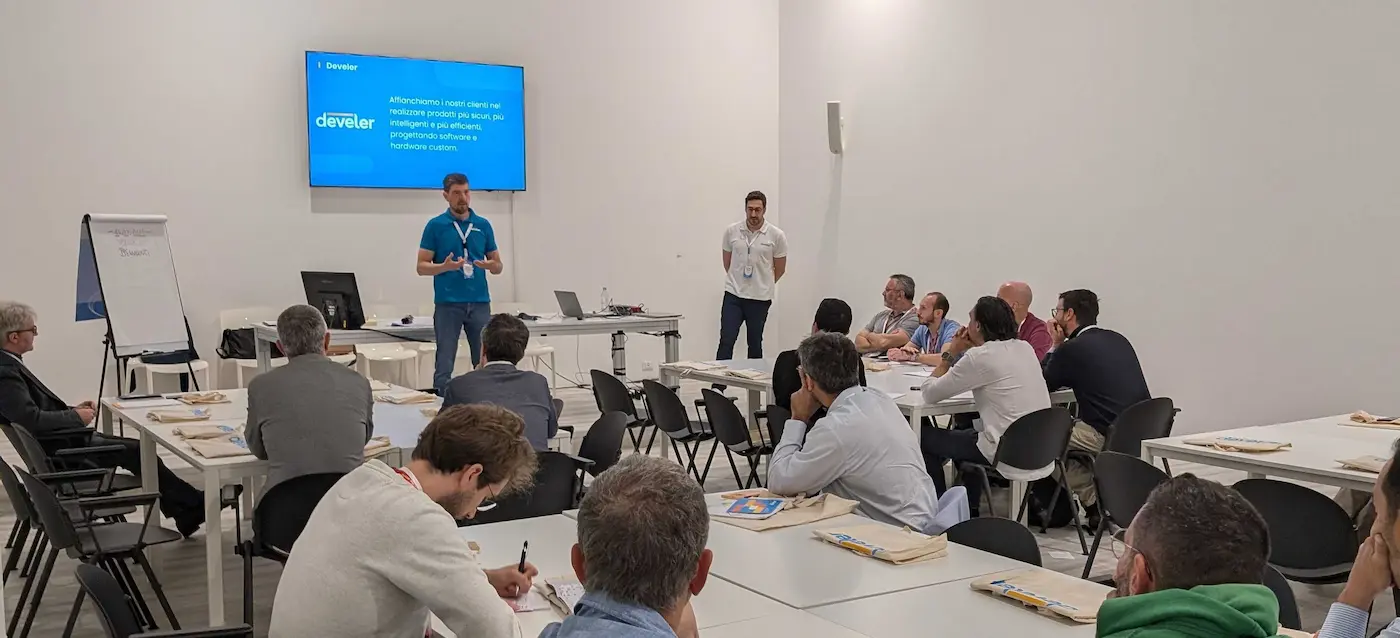Design Better – Develer’s Workshop at SPS 2025

During the latest edition of SPS Italia, Develer took an important step: bringing not only advanced technological solutions to the fair, but also a new vision of how projects can be born and grow. For the first time, we offered a workshop dedicated to collaborative design, an approach in which we are among the pioneers in the Italian industrial landscape.
Leading the workshop was Matteo Forni, product designer at Develer, who engaged participants in an intense morning: practical tools, uncomfortable questions, and reflections on how to make better decisions in technological projects.
We had a quick chat with him at the end of the event to gather impressions, insights, and some advice for those who couldn’t attend.
How did it go? What were your impressions during the workshop?
I’d say it went well! I sensed a lot of interest in the topic of collaborative design. This shows that even in the industrial sector, there’s still room to explore: design aimed at streamlining processes and creating value by putting people at the center. Collaborating, talking, identifying problems and solutions together – it’s a different, but extremely effective, way of working.
What kind of audience attended the workshop? Were there any profiles or questions that stood out to you?
The audience was very specialized: professionals and technicians from the industrial world. But this is exactly what made the contributions interesting. Some participants, starting from the examples we presented, managed to reinterpret them in the context of their own companies, even in very different sectors. The questions that emerged showed that the tools presented can be adapted to various scenarios, such as production or prototype development.
What was the main goal of the workshop?
We wanted to deliver a clear message: collaborative design isn’t just for creating consumer products. It’s an approach that can also work in B2B, without upheaval, but by embracing its core values: discussion, co-creation, stakeholder involvement. Bringing it to SPS, in a technical industrial context, was a significant gesture for us. We feel like pioneers in this, and we’re proud of it.
What tools or methods did you present?
We worked with very concrete tools:
- The stakeholder matrix, to understand who to involve in a project.
- Depth diagrams, useful for mapping services, processes, or the use of machinery over time, with a high level of detail.
- A collaborative method for estimates and roadmaps, which helps bridge the historical gap between those who design, those who build, and those who use. By uniting different perspectives, we can reduce complexity and create more focused products.
What’s the hardest part for companies to accept when proposing this approach?
The critical point is often the language. When we talk about “design,” it’s still associated with something aesthetic or decorative. But design is about building beauty – it’s also about building that aesthetic, emotional, and functional component that aims to create products that are easy, accessible, and memorable to use. Doing it together, in a structured way, is the core of collaborative design.
What mistakes does this approach help avoid, especially in technological projects?
Technological projects are often hyper-complex, and trying to map everything in minute detail can become a mistake. The collaborative approach encourages us to focus on what truly matters to the people who use the product or service.
It helps reduce the superfluous, avoid adding unnecessary features, or designing based on assumptions and biases. If we don’t talk to the right people, we’ll never know if a feature is truly needed, and we risk wasting time and resources.
What do you hope participants took away from the workshop?
Our goal is always to provide tools that can be applied immediately. I hope those who attended went back to work with the desire to try, even on just a small known issue, one of the methods we proposed.
But above all, I hope they took home a new unit of measurement: the value perceived by people, even before specifications and extremely detailed technical documents.
Will you offer the workshop again? Will there be any changes or new versions?
Yes, we want to offer it again. And make it even more challenging: I’d love to tackle examples and questions that come from contexts very far from “classic” design.
“Can I use this approach for a hardware board?” “Or to change a production phase?” These are stimulating challenges, and I’d like the workshop to become a chance to explore those possibilities too.
For many, the workshop was a chance to discover that designing together is truly possible. You just need the right tools and the willingness to step out of your role and into someone else’s shoes.
And for those who couldn’t attend, it’s not the final word: we’re already thinking about new opportunities to take collaborative design beyond the slides and into companies.